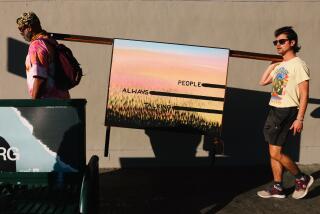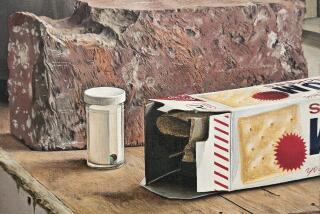Book Review: ‘Rebels in Paradise’ by Hunter Drohojowska-Philp
Rebels in Paradise
The Los Angeles Art Scene and the 1960s
Hunter Drohojowska-Philp
Henry Holt: 288 pp., $27
After decades of neglect, Los Angeles art history is a hot topic. The most immediate reason is “Pacific Standard Time: L.A. Art 1945-1980,” an enormous collaborative venture spearheaded by the Getty Foundation and Getty Research Institute. Dozens of exhibitions and related publications exploring the city’s rise as an art capital will appear this fall and winter in cultural institutions from San Diego to Santa Barbara.
“Rebels in Paradise” is an independent project — served up just in time to be savored as an appetizer for the upcoming feast. More Vanity Fair than standard art history, it’s an affectionate, deliciously gossipy account of the decade when a convergence of renegade artists, entrepreneurs, curators, collectors and writers put Los Angeles on the art world’s map. Hunter Drohojowska-Philp, a longtime observer of the scene and a biographer of artist Georgia O’Keeffe, calls her new book “a love letter to Los Angeles, still a place of perpetual possibility and infinite invention.”
She has conducted numerous interviews and pored over oral histories, exhibition catalogs, books and magazines to compile a scrapbook-like story of the period’s leading personalities. A 1955-69 timeline provides a chronological guide to loosely organized chapters on events, groups of compatriots and individual artists. Painter Billy Al Bengston emerges as a gifted but arrogant charmer with a mean streak; sculptor Larry Bell, as an innocent rising star, ill-equipped to deal with his early success; curator Walter Hopps, as a brilliant thinker but unreliable do-er, given to inconvenient disappearances.
The featured artists “chose to live in Los Angeles instead of New York,” Drohojowska-Philp writes, “precisely because there was a dearth of critical discourse and gallery infrastructure. As a group, they reveled in being pugnacious and anti-intellectual. Unlike the Abstract Expressionist painters who had been their heroes, they took a stand for optimism, humor and pleasure. Though most came from quite modest backgrounds, they refused to adopt the sorrowful introspection and angst of the New York School artists.”
The book starts with two landmark events in fall 1963: the debut of Andy Warhol’s portraits of Elvis Presley and Elizabeth Taylor, at Ferus Gallery, and the first retrospective exhibition of Dada artist Marcel Duchamp’s work, organized by Hopps at the Pasadena Art Museum. “The back-to-back receptions in honor of Warhol and Duchamp invigorated the feisty Los Angeles art scene,” the author writes. The achievements of Duchamp, an eccentric outsider, encouraged adventurous young artists to blaze their own trails, while Warhol’s endorsement of the L.A. scene heightened hopes that their work might gain recognition in New York and Europe.
The second chapter dips back to the late 1950s to cover the beginnings of Ferus, “the first gallery in Los Angeles to capture the zeitgeist,” as Drohojowska-Philp describes it. Much of the material about the evolution of the gallery and the renowned artists who launched careers there is familiar from Kristine McKenna’s 2009 book, “The Ferus Gallery: A Place to Begin.” But “Rebels in Paradise” has a broader mission.
There are sections on other leading galleries — most notably Virginia Dwan and Nicholas Wilder — as well as artists David Hockney and John Baldessari, architect Frank Gehry, fashion designer Rudi Gernreich, innovators in plastic sculpture and founders of the Light and Space movement. Drohojowska-Philp also recalls the brief L.A. life of Artforum magazine, the formation of Gemini Graphic Editions Limited, the opening of the Los Angeles County Museum of Art and the civil uprising known as the Watts Riots.
Readers who are new to any or all of this may have difficulty figuring out how the components fit together. Those in search of the art part of the story will find that it gets lost in tales of the marriages, divorces, love affairs and sex lives of the artists — and their relatives and friends. Drohojowska-Philp also revels in physical descriptions of her subjects, anecdotes and juicy details.
Who knew that Eve Babitz — the 19-year-old nude who played chess with Duchamp at the Pasadena Art Museum — wore a size 36 DDD bra? Or that Gehry participated in a rock band of makeshift instruments by ringing a bicycle bell and pumping a toilet plunger in a pail?
As for Ed Kienholz, a maker of gritty assemblages and a founder of Ferus, the author reveals that he briefly taught art at a Las Vegas escort service disguised as a self-improvement school. Readers also learn that he christened the chicken-wire figures in his “Back Seat Dodge ‘38” sculpture “Harold” and “Mildred” and that he demanded — and received — a percentage of ticket sales to his controversial retrospective exhibition at LACMA in 1966.
Such tidbits are fun, but “Rebels in Paradise” is not the definitive book on Los Angeles art of the 1960s. It’s an entertaining, often insightful guide to the spirit of the scene.
A former Times staff writer, Muchnic is the author of “Odd Man In: Norton Simon and the Pursuit of Culture.”
More to Read
Sign up for our Book Club newsletter
Get the latest news, events and more from the Los Angeles Times Book Club, and help us get L.A. reading and talking.
You may occasionally receive promotional content from the Los Angeles Times.






